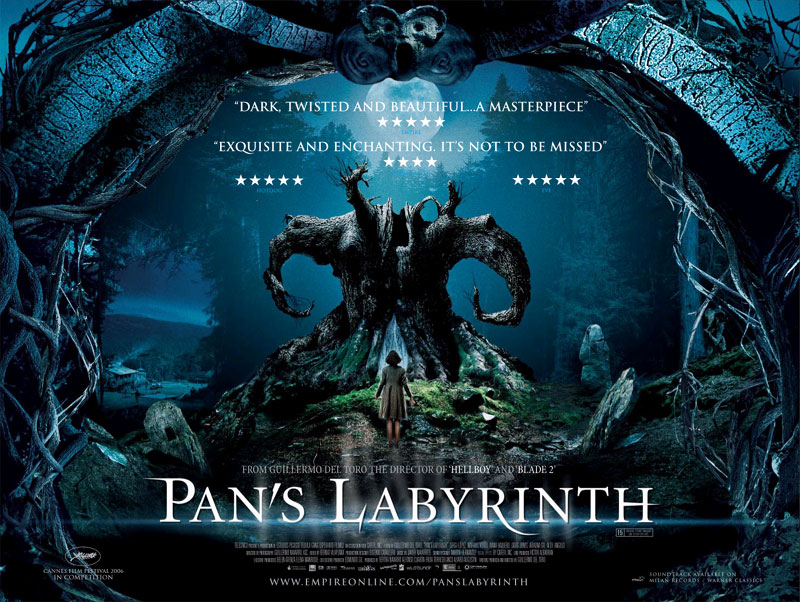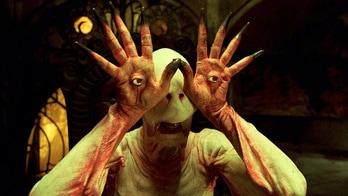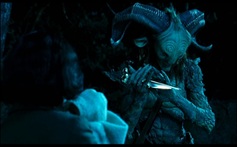[Note: This review assumes you have already seen the film and are familiar with basic plot details]
Set in the spring of 1944, Pan's Labyrinth takes place in the aftermath of Spain's civil war between the fascist and communist parties. Ofelia is a young girl with a strong imagination struggling to make sense of family trauma and societal violence. The movie begins as Ofelia and her pregnant mother Carmen travel to a remote wooded town to meet her new stepfather, Captain Vidal. There, in a decrepit labyrinth, she encounters a faun who believes she is the lost princess to a forgotten kingdom. Giving her three tasks, the faun promises her immortality if she completes them successfully. The remainder of the film follows Ofelia as she tries to accomplish this herculean mission.
Ofelia's relationship with Carmen is the driving force behind the world of fantasy she finds herself in. Her first task is to retrieve a key from a giant toad living under a tree shaped like the female reproductive system (scroll up to the picture if you have any doubts).[3] The fallopian tree symbolizes Carmen's womb, while the toad represents Ofelia's unborn brother. As the toad is killing the tree, so the baby is killing his mother.
Inherent in the first task is the struggle many children face when they feel threatened by the birth of a sibling. Ofelia is afraid of being replaced and terrified of losing her only remaining birth parent. Fantasy is her coping mechanism; in her imagination, she kills the toad and saves the tree from death.[4] In reality, she has no such power, as the destruction of her mandrake root shows.
Guided by fairies, Ofelia's second task is to retrieve a dagger from the sleeping Pale Man (one of my favorite Hollywood monsters, played masterfully by Doug Jones). Despite the faun’s strict warning against eating food from the Pale Man’s table, Ofelia cannot resist. Impelled by curiosity and desire, she steals two grapes. This awakens the creature, who attacks her and devours the fairies trying to protect her. Prior to this scene, Vidal was shown at a similar table with his guests. At Vidal's dinner, Ofelia was ordered to wear a special dress to impress the visitors, but curiosity getting the better of her, she wanders into the woods and ruins her dress, inciting Vidal’s anger. Carmen intervenes for her daughter, but the stress of her action causes her to collapse, threatening her pregnancy.
| The second task reflects Ofelia's awareness of action and consequence, played out in imaginative terms. The hallway to the Pale Man's feast were intentionally painted a deep blood red and were designed to evoke reminiscence of a womb, as Ofelia again struggles with the motherhood/childhood relationship. It is easy for a child to feel responsible for the suffering of a parent rather than to accept the other's choice of self-sacrifice. Ofelia's interaction with the Pale Man reflects her feelings of misplaced guilt for hurting her mother and fear at waking Vidal's lightly slumbering wrath. |
The Church played a significant role in Fascism's rise in Spain, in fact, the words the priest speaks during another scene reflect an actual quote from a priest Del Toro discovered while researching the Spanish Civil War. Offering communion to political prisoners who were to be tortured, the priest would say: "Remember my sons, you should confess what you know because God doesn't care what happens to your bodies; He already saved your souls."[5]
If the first task represented Ofelia's struggle with insecurity over the looming birth of her brother, the third task reveals that she has wrestled the demon of jealousy into submission. The faun tells Ofelia that only her brother’s blood can unlock the door to her secret kingdom, but Ofelia refuses to kill him. Instead, [spoiler alert] she dies trying to protect him. By choosing to risk her life for her half brother, Ofelia becomes a responsible agent capable of acting justly to save the innocent.
| Prior to this point, she had followed others' instructions, only disobeying when youthful curiosity led her astray. At the crux of the film, however, when her salvation seems dependent upon her continuing obedience to the faun, Ofelia chooses to give up her rights to her kingdom rather than allow harm to come to her infant brother. |
Pan's Labyrinth is difficult to sit through, but easy to delight in. It reveals humanity at its darkest, yet through the sacrifices of several characters, teaches us that even the blackest night is dispelled by light. While the violence in this film is not forgettable, neither is it gratuitous. Rather, it reminds us of the monsters we know in our own world. Similarly, Ofelia reminds us that evil will only be overcome when we break the cycle of violence through our own willingness to sacrifice. “In darkness there can be light. In misery, there can be beauty. In death, there can be life.”[5]
----------
Further reading:
[1] G.K. Chesterton, Tremendous Trifles (New York: Dodd, Mead and Company, 1930), 130.
[2] One might argue, with Dietrich Bonhoeffer as an ally, that regardless of the director's intent, the fantasy realm in this film is perhaps more true than the reality, for it portrays the reality of Ofelia's perception of her place within her family and community. cf. Dietrich Bonhoeffer, Ethics (London: SCM Press, 1971).
[3] Guillermo Del Toro Talks 'Pan's Labyrinth', Youtube, directed by Marcus Leshock (Chicago, IL: CLTV, 2007), http://www.youtube.com/watch?v=m5oxIARPSHw&feature=related (accessed October 27, 2012).
[4] We should not read into this that Ofelia wants to kill her brother. In her fantasy, she is unaware that the toad will die and is simply following the faun’s orders. Her true intention is to save her mother, not kill her brother. The ambiguous nature of this fantasy seem to reflect the confusion of a terrified child, rather than the malintent of a spiteful adult.
[5] Guillermo Del Toro, Pan's Labyrinth: Inside the Creation of a Modern Fairy Tale (Harper Design, 2016).
[6] Guillermo Del Toro, 2 minute trailer for Pan's Labyrinth, Youtube, directed by Guillermo Del Toro (Burbank, CA: Newline, 2006), http://www.youtube.com/watch?v=EqYiSlkvRuw (accessed October 27, 2012).



 RSS Feed
RSS Feed
